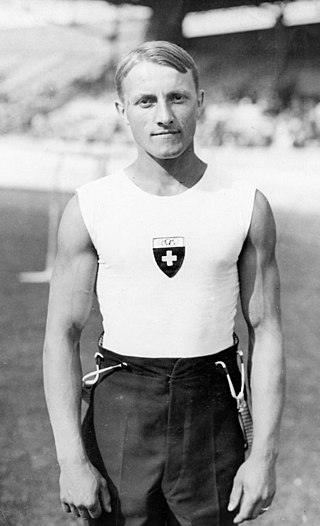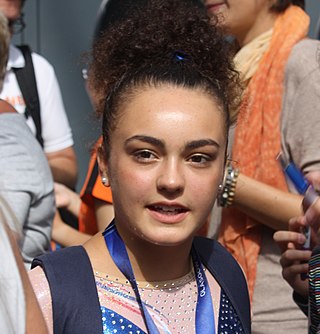
Gymnastics is a type of sport that includes physical exercises requiring balance, strength, flexibility, agility, coordination, artistry and endurance. The movements involved in gymnastics contribute to the development of the arms, legs, shoulders, back, chest, and abdominal muscle groups. Gymnastics evolved from exercises used by the ancient Greeks that included skills for mounting and dismounting a horse, and from circus performance skills.

Artistic gymnastics is a discipline of gymnastics in which athletes perform short routines on different types of apparatus. The sport is governed by the Fédération Internationale de Gymnastique (FIG), which assigns the Code of Points used to score performances and regulates all aspects of elite international competition. Within individual countries, gymnastics is regulated by national federations such as British Gymnastics and USA Gymnastics. Artistic gymnastics is a popular spectator sport at many competitions, including the Summer Olympic Games.

The 1924 Summer Olympics, officially known as the Games of the VIII Olympiad, was an international multi-sport event held in Paris, France, from 4 May to 27 July. A total of 3,089 athletes from 44 nations participated in 126 events in 17 sports across 23 different disciplines.

Gymnastics events have been contested at every Summer Olympic Games since the birth of the modern Olympic movement at the 1896 Summer Olympics in Athens. For 32 years, only men were allowed to compete. Beginning at the 1928 Summer Olympics in Amsterdam, women were allowed to compete in artistic gymnastics events as well. Rhythmic gymnastics events were introduced at the 1984 Summer Olympics in Los Angeles, and trampoline events were added at the 2000 Summer Olympics in Sydney.

France was the host nation for the 1924 Summer Olympics in Paris. It was the second time that France had hosted the Games, after the 1900 Summer Olympics, also in Paris. 401 competitors, 373 men and 28 women, took part in 128 events in 20 sports.
At the 1928 Summer Olympics in Amsterdam, eight events in gymnastics were contested. For the first time at the Olympic Games, women competed in gymnastics. The rope climbing and sidehorse vault events were dropped from the program.

Albert Séguin was a French gymnast and Olympic champion. He competed at the 1924 Summer Olympics, where he received a gold medal in sidehorse vault, and silver medals in rope climbing and in team combined exercises.

Jean Gounot was a French gymnast and Olympic medalist. He competed at the 1920 Summer Olympics in Antwerp, where he received a bronze medal in all-round individual.

François Gangloff was a French gymnast and Olympic medalist. He competed at the 1924 Summer Olympics in Paris, where he received a silver medal in sidehorse vault, and a silver medal and in team combined exercises.
The men's vault event was part of the gymnastics programme at the 1924 Summer Olympics. It was one of nine gymnastics events and it was contested for the third time after 1896 and 1904. The competition was held on Monday, July 21, 1924. Seventy gymnasts from nine nations competed. The eight members of each nation's gymnastics team all competed; Czechoslovakia only had six competitors start the vault. The event was won by Frank Kriz of the United States, the nation's second consecutive victory in the event. Jan Koutný and Bohumil Mořkovský of Czechoslovakia took silver and bronze, respectively, the nation's first medals in the event.

The men's artistic individual all-around event was part of the gymnastics programme at the 1924 Summer Olympics. It was one of nine gymnastics events and it was contested for the sixth time. The competition was held from Thursday, 17 July 1924, to Wednesday, 23 July 1924. Seventy-two gymnasts from nine nations competed. Each nation could send up to 8 gymnasts, up from 6 in previous Games. For the first time since 1904, the scores for individual competitors were used to calculate a team score. The men's artistic individual all-around was won by Leon Štukelj of Yugoslavia. Czechoslovakia's Robert Pražák took silver, while Bedřich Šupčík earned bronze. Both nations were making their debut in the event.

Bohumil Mořkovský was a Czech gymnast who competed for Czechoslovakia in the 1924 Summer Olympics. He was born and died in Valašské Meziříčí, Moravia. He died less than a month before he could have made a repeat Olympic appearance.

The men's vault or "long horse vaulting" event was part of the gymnastics programme at the 1932 Summer Olympics. It was contested for the fifth time after 1896, 1904, 1924, and 1928. The competition was held on Wednesday, August 10, 1932. Ten gymnasts from four nations competed. Each nation was limited to three gymnasts. The event was won by Savino Guglielmetti of Italy, the nation's first medal in the event. Americans Al Jochim and Ed Carmichael took silver and bronze, respectively.

The men's vault event was part of the gymnastics programme at the 1928 Summer Olympics held in Amsterdam. It was one of seven gymnastics events for men and it was contested for the fourth time after 1896, 1904, and 1924. Scores from the vault event were added to the results from other individual apparatus events to give aggregate scores for the individual and team all-around events. There were 85 competitors from 11 nations. Each nation had a team of 8 gymnasts; three of the 88 men did not start. The event was won by Eugen Mack of Switzerland, the nation's first victory in the event and first medal since 1896. Emanuel Löffler gave Czechoslovakia its second consecutive silver medal. Stane Derganc's bronze was Yugoslavia's first medal in the event.

The men's artistic individual all-around event was part of the gymnastics programme at the 1928 Summer Olympics. It was one of seven gymnastics events for men and was the seventh Olympic men's all-around gymnastic championship. Scores from the individual apparatus events were added to give aggregate scores for the individual all-around; individual all-around scores were similarly summed for the team all-around event. There were 88 competitors from 11 nations. Each nation sent a team of 8 gymnasts. The event was won by Georges Miez of Switzerland, with his countryman Hermann Hänggi taking silver. They were the first medals in the event for Swiss gymnasts since 1904 and the first gold medal ever for a Swiss man in the individual all-around. Defending Olympic champion Leon Štukelj of Yugoslavia finished with the bronze this time, making him the third man to win multiple medals in the event.
Manrique Larduet Bicet is a Cuban artistic gymnast. At the 2015 World Championships, he won the silver medal in the all-around- becoming Cuba's first World all-around medalist. He is also the 2015 World horizontal bar bronze medalist, and he represented Cuba at the 2016 Summer Olympics. He is the 2015 Pan American Games vault champion and all-around silver medalist. He is the 2018 Pan American all-around champion and a two-time Pan American champion on the parallel bars At the 2014 Pan American Sports Festival he won medals in every event, including the all-around gold. He withdrew from the 2020 Summer Olympics due to a dispute with the Cuban Gymnastics Federation, and he now lives and trains in Italy.

Shek Wai Hung is an artistic gymnast from Hong Kong. He is the current Asian Games champion on vault.

Coline Devillard is a French artistic gymnast. Devillard is the 2022 World bronze medalist, the 2017, 2023, 2024 European champion and the 2019 European silver medalist on vault. She is the first and only French female gymnast to win the European title on vault. Additionally she was part of the French teams that won silver at the 2018 European Championships and bronze at the 2023 World Championships. She competed in the 2024 Summer Olympics.
Audrys Nin Reyes is a Dominican artistic gymnast. He is the 2019 and 2023 Pan American Games vault champion. He was the first Dominican gymnast to win a gold medal at the Pan American Games. He was also the first Dominican gymnast to win a gold medal at an FIG World Cup event when he won the vault title at the 2017 Osijek World Challenge Cup. He is the 2017 Pan American vault and horizontal bar champion and the 2017 Universiade vault champion. He is also the 2018 and 2023 Central American and Caribbean Games vault champion. He has qualified to represent the Dominican Republic at the 2024 Summer Olympics, the first male gymnast from his country to do so.

The vault is an artistic gymnastics event held at the Summer Olympics. The event was first held for men at the first modern Olympics in 1896. It was held again in 1904, but not in 1900, 1908, 1912, or 1920 when no apparatus events were awarded medals. The vault was one of the components of the men's artistic individual all-around in 1900, however. The men's vault returned as a medal event in 1924 and has been held every Games since. Vault scores were included in the individual all-around for 1924 and 1928, with no separate apparatus final. In 1932, the vault was entirely separate from the all-around. From 1936 to 1956, there were again no separate apparatus finals with the vault scores used in the all-around. The women's vault was added in 1952 and has been held every Games since. Beginning in 1960, there were separate apparatus finals.















